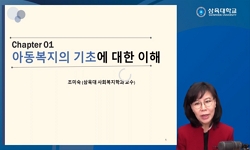본 연구는 타인의 표정을 인식할 때 함께 제공되는 언어 정보가 정서 인식에 영향을 주는 현상이 관찰되는 연령의 하한계를 알아보기 위한 목적으로, 학령전기 아동을 대상으로 언어 정보와...
http://chineseinput.net/에서 pinyin(병음)방식으로 중국어를 변환할 수 있습니다.
변환된 중국어를 복사하여 사용하시면 됩니다.
- 中文 을 입력하시려면 zhongwen을 입력하시고 space를누르시면됩니다.
- 北京 을 입력하시려면 beijing을 입력하시고 space를 누르시면 됩니다.

언어 정보와 얼굴 표정의 정서가 불일치할 때, 3세 아동은 어떤 정보에 주목하여 타인의 정서를 판단할까?: 점화 과제 연구 = Three-Year-Old Children Focus on Emotional Adjectives When Linguistic Context and Facial Expression were Not Congruent: The Priming Task Research
한글로보기https://www.riss.kr/link?id=A103650218
-
저자
박윤희 (교토대학교 문학연구과) ; Itakura Shoji (교토대학교 문학연구과)

- 발행기관
- 학술지명
- 권호사항
-
발행연도
2017
-
작성언어
Korean
-
주제어
Children ; Facial Expression Recognition ; Emotion ; Linguistic Information ; Priming Task. ; 아동 ; 언어 정보 ; 얼굴 표정 ; 정서 ; 점화 과제.
-
등재정보
KCI등재
-
자료형태
학술저널
-
수록면
51-70(20쪽)
-
KCI 피인용횟수
1
- DOI식별코드
- 제공처
-
0
상세조회 -
0
다운로드
부가정보
국문 초록 (Abstract)
본 연구는 타인의 표정을 인식할 때 함께 제공되는 언어 정보가 정서 인식에 영향을 주는 현상이 관찰되는 연령의 하한계를 알아보기 위한 목적으로, 학령전기 아동을 대상으로 언어 정보와 얼굴 표정을 순차적으로 제시하는 점화 과제를 실시하여 언어 정보에 따른 아동의 정서 인식의 변화를 관찰하였다. 연구 대상은 의료기관으로부터 언어장애나 정서발달장애 진단을 받은 경험이 없는 3세 0개월에서 3세 11개월 사이의 아동이었다. 점화과제에서 참가자에게 형용사(예-기뻐요, 슬퍼요)나 정서 상황(예-생일 선물을 받다, 키우던 강아지를 잃어버렸다)에 대한 언어 정보를 청각적으로 제시한 후, 5세 아동의 기쁨 또는 슬픔 표정 사진을 제시하여 사진 속 주인공의 정서를 판단하도록 요청하였다. 언어 정보는 형용사만 제시되는 단순한 언어 정보 조건(예-기뻐요), 정서와 관련성이 높은 상황 정보가 제시되는 구체적 언어 정보 조건(예-생일 선물을 받아서 기뻐요), 정서와 관련성이 낮은 상황 정보가 제시되는 애매한 언어 정보 조건(예-문을 열어서 기뻐요)으로 구성되었으며, 참가자들은 세 가지 조건 중 한 가지 조건에 무선 배정되었다. 모든 참가자들은 언어 정보와 표정의 정서가 일치하는 시행과 불일치하는 시행에서 사진 속 주인공의 정서를 판단하였고, 주인공의 얼굴 표정에 따라 정서를 판단하였을 경우 정답으로, 언어 정보에 따라 정서를 판단하였을 경우 오답으로 처리하여 각 집단 별 점화 과제 점수를 산출하였다. 그 결과, 모든 언어 정보 집단에서 언어 정보와 얼굴 표정의 정서가 불일치할 때 점화 과제 점수가 유의하게 감소하였다. 본 연구의 결과는 3세 아동이 다양한 상황 간의 정서적 의미의 강도를 비교하는 것을 어려워하지만, 언어적으로 제시된 상황 정보와 얼굴 표정의 정서가 불일치할 때, 얼굴 표정보다는 언어적으로 제시된 형용사로 타인의 정서 상태를 추론함을 보여 준다. 또한, 적어도 생후 3년 이후에서 타인의 정서 인식에 대한 언어 정보의 영향이 관찰될 수 있다는 것을 시사한다. 논의에서는, 이러한 결과에 대하여 본 연구에서 사용된 언어 정보의 구조의 특성, 연령에 따른 정서의 원인에 대한 이해 발달 차이, 3세 아동의 형용사 이해의 용이성 등의 관점에서 설명하였으며, 마지막으로, 정서 및 언어 발달 장애 연구에의 응용에 대해 논하였다.
다국어 초록 (Multilingual Abstract)
This study investigated that whether three-year-old children in normal emotion and language development, more focus on linguistic contexts about emotional situations than facial expressions to judge the other’s emotions, expecially when emotions of ...
This study investigated that whether three-year-old children in normal emotion and language development, more focus on linguistic contexts about emotional situations than facial expressions to judge the other’s emotions, expecially when emotions of the situation and the facial expression are not congruent. Using priming task paradigm, a linguistic context sentence was acoustically presented as primer stimulus, after that, a happy face or a sad face was immediately presented on the monitor as target stimulus. There were three linguistic information groups: a) Simple information(SI)-emotional adjectives, b) Elaborative information(EI)- emotional adjectives with situational information related to the adjectives, c) Ambiguous information(AI)-emotional adjectives with situational information not related to the adjectives. Participants asked to judge the emotional states of protagonists of facial expressions. The priming task score was calculated and compared among groups. As a result, all group’s task score were decreased when emotions of the situation and the facial expression are not congruent. Three-year-old children may struggle to compare emotional intensity of elaborative context and that of ambiguous context. However, sentences of all linguistic context contained emotional adjectives, happy and sad. Hence, it seems that three-year-old children focus on and use the adjectives to infer the other’s emotional state when emotions of the situation and the facial expression are incongruent. In discussion, we discussed the result of the present study in terms of three perspectives: structural feature of the linguistic information, developmental difference on understanding of reason for emotion, and easiness to use emotional adjectives to infer other’s emotional state in three-year-old children. Finally, we suggested that this study could applicate to future investigation to explore how children with emotional and language impairment perceive and recognize the interaction between language and emotion information.
참고문헌 (Reference)
1 남궁 정, "학령기 단순언어장애 아동의 정서어휘이해력 특성" 이화여자대학교 대학원 2010
2 강위영, "발달장애 아동을 위한 언어․행동치료의 실제" 교육과학사 2003
3 정훈영, "감각 자극 양식에 따른 고기능 자폐아의 정서인식 특성" 한국정서행동장애학회 26 (26): 77-93, 2010
4 板倉昭二, "感情科学" 京都大学学術出版会 113-141, 2007
5 森野美央, "幼児期における心の理論発達の個人差, 感情理解発達の個人差, 及び仲間との相互作用の関連" 16 (16): 36-45, 2005
6 渡辺弥生, "幼児の共感と母親の共感との関係" 34 : 324-331, 1986
7 平森秀美, "他者の感情を推論する能力の発達" 6 : 71-85, 1990
8 Denham, S. A., "‘Baby looks very sad’ : Implications of conversations about feelings between mother and preschooler" 10 (10): 301-315, 1992
9 Peter, M., "When and how do children develop knowledge of verb argument structure? Evidence from verb bias effects in a structural priming task" 81 (81): 1-15, 2015
10 Friend, M., "What should I do? Behavior regulation by language and paralanguage in early childhood" 4 (4): 161-183, 2003
1 남궁 정, "학령기 단순언어장애 아동의 정서어휘이해력 특성" 이화여자대학교 대학원 2010
2 강위영, "발달장애 아동을 위한 언어․행동치료의 실제" 교육과학사 2003
3 정훈영, "감각 자극 양식에 따른 고기능 자폐아의 정서인식 특성" 한국정서행동장애학회 26 (26): 77-93, 2010
4 板倉昭二, "感情科学" 京都大学学術出版会 113-141, 2007
5 森野美央, "幼児期における心の理論発達の個人差, 感情理解発達の個人差, 及び仲間との相互作用の関連" 16 (16): 36-45, 2005
6 渡辺弥生, "幼児の共感と母親の共感との関係" 34 : 324-331, 1986
7 平森秀美, "他者の感情を推論する能力の発達" 6 : 71-85, 1990
8 Denham, S. A., "‘Baby looks very sad’ : Implications of conversations about feelings between mother and preschooler" 10 (10): 301-315, 1992
9 Peter, M., "When and how do children develop knowledge of verb argument structure? Evidence from verb bias effects in a structural priming task" 81 (81): 1-15, 2015
10 Friend, M., "What should I do? Behavior regulation by language and paralanguage in early childhood" 4 (4): 161-183, 2003
11 Aguert, M., "Understanding expressive speech acts: The role of prosody and situational context in French-speaking 5-to 9-year-olds" 53 (53): 1629-1641, 2010
12 Spackman, M. P., "Understanding emotions in context : The effects of language impairment on children’s ability to infer emotional reactions" 41 (41): 173-188, 2006
13 Walker-Andrews, A. S., "The development of social cognition" Psychology Press 161-186, 1997
14 Jones, D. C., "The development of display rule knowledge : Linkages with family expressiveness and social competence" 69 (69): 1209-1222, 1998
15 Roberson, D., "The categorical perception of colors and facial expressions : The effect of verbal interference" 28 (28): 977-986, 2000
16 Taumoepeau, M., "Stepping stones to others’ minds : Maternal talk relates to child mental state language and emotion understanding at 15, 24, and 33 months" 79 (79): 284-302, 2008
17 Lieberman, M. D., "Putting feelings into words affect labeling disrupts amygdala activity in response to affective stimuli" 18 (18): 421-428, 2007
18 Lagattuta, K. H., "Preschoolers’ understanding of the link between thinking and feeling : Cognitive cuing and emotional change" 68 (68): 1081-1104, 1997
19 上野一彦, "PVT-R絵画語い発達検査" 日本文化科学社 2008
20 Park, Y. H., "Modulation of emotional recognition of facial expression by linguistic context in Japanese preschoolers"
21 Garner, P. W., "Low‐Income mothers’ conversations about emotions and their children’s emotional competence" 6 (6): 37-52, 1997
22 Bretherton, I., "Learning to talk about emotions : A functionalist perspective" 57 (57): 529-548, 1986
23 Barrett, L. F., "Language as context for the perception of emotion" 11 (11): 327-332, 2007
24 Diéguez-Risco, T., "Judging emotional congruency : Explicit attention to situational context modulates processing of facial expressions of emotion" 112 : 27-38, 2015
25 Gardner, D., "Japanese children’s understanding of the distinction between real and apparent emotion" 11 (11): 203-218, 1988
26 Neville, H. F., "Is this a phase? Child development & parent strategies, birth to 6 years" Parenting 2007
27 Ford, J. A., "Inferring emotional reactions in social situations: Differences in children with language impairment" 46 (46): 21-30, 2003
28 Joshi, M. S., "Indian and English children’s understanding of the distinction between real and apparent emotion" 65 (65): 1372-1384, 1994
29 Trope, Y., "Identification and inferential processes in dispositional attribution" 93 (93): 239-257, 1986
30 Banerjee, M., "Hidden emotions : Preschoolers’ knowledge of appearance-reality and emotion display rules" 15 (15): 107-132, 1997
31 Gross, D., "False beliefs about emotion : Children’s understanding of misleading emotional displays" 11 (11): 475-488, 1988
32 Diéguez-Risco, T., "Faces in context : Modulation of expression processing by situational information" 8 (8): 601-620, 2013
33 Ekman, P., "Emotion in the human face: Guidelines for research and an integration of findings" Elsevier 2013
34 Pons, F., "Emotion comprehension between 3and 11 years : Developmental periods and hierarchical organization" 1 (1): 127-152, 2004
35 Halberstadt, J. B., "Effects of emotion concepts on perceptual memory for emotional expressions" 81 (81): 587-598, 2001
36 Carroll, J. M., "Do facial expressions signal specific emotions? Judging emotion from the face in context" 70 (70): 205-218, 1996
37 Eskritt, M., "Do actions speak louder than words? Preschool children’s use of the verbal-nonverbal consistency principle during inconsistent communications" 27 (27): 25-41, 2003
38 Walden, T. A., "Discrimination of facial expressions by preschool children" 53 (53): 1312-1319, 1982
39 Ekman, P., "Constants across cultures in the face and emotion" 17 (17): 124-129, 1971
40 Harris, P. L., "Children’s understanding of the distinction between real and apparent emotion" 57 (57): 895-909, 1986
41 Saarni, C., "Children’s understanding of display rules for expressive behavior" 15 (15): 424-429, 1979
42 Ridgeway, D., "Acquisition of emotion-descriptive language : Receptive and productive vocabulary norms for ages 18 months to 6years" 21 (21): 901-908, 1985
43 Friend, M., "A developmental lexical bias in the interpretation of discrepant messages" 46 (46): 342-369, 2000
동일학술지(권/호) 다른 논문
-
대학생의 불안정 성인애착과 이성 관계 만족의 관계: 회피-분산적 정서조절양식의 매개효과
- 한국정서행동장애학회
- 고민정
- 2017
- KCI등재
-
중·고등학생의 자원봉사와 안녕감의 관계에서 회복탄력성의 매개효과
- 한국정서행동장애학회
- 정경숙
- 2017
- KCI등재
-
신체경험중심 심리운동이 지적장애 아동의 운동성과 적응행동에 미치는 영향
- 한국정서행동장애학회
- 송호준
- 2017
- KCI등재
-
유아기질과 부모역할지능이 유아의 문제행동에 미치는 영향: 유아적응유연성의 매개효과를 중심으로
- 한국정서행동장애학회
- 정주연
- 2017
- KCI등재
분석정보
인용정보 인용지수 설명보기
학술지 이력
| 연월일 | 이력구분 | 이력상세 | 등재구분 |
|---|---|---|---|
| 2026 | 평가예정 | 재인증평가 신청대상 (재인증) | |
| 2020-01-01 | 평가 | 등재학술지 유지 (재인증) |  |
| 2018-03-22 | 학회명변경 | 영문명 : Korean Society For The Emotional & Behavioral Disorders -> The Korean Society of Emotional and Behavioral Disorders |  |
| 2018-01-02 | 학회명변경 | 한글명 : 한국정서·행동장애아교육학회 -> 한국정서행동장애학회 |  |
| 2017-01-01 | 평가 | 등재학술지 유지 (계속평가) |  |
| 2013-01-01 | 평가 | 등재학술지 유지 (등재유지) |  |
| 2010-01-01 | 평가 | 등재학술지 유지 (등재유지) |  |
| 2008-01-01 | 평가 | 등재학술지 유지 (등재유지) |  |
| 2006-01-01 | 평가 | 등재학술지 유지 (등재유지) |  |
| 2003-01-01 | 평가 | 등재학술지 선정 (등재후보2차) |  |
| 2002-01-01 | 평가 | 등재후보 1차 PASS (등재후보1차) |  |
| 2000-07-01 | 평가 | 등재후보학술지 선정 (신규평가) |  |
학술지 인용정보
| 기준연도 | WOS-KCI 통합IF(2년) | KCIF(2년) | KCIF(3년) |
|---|---|---|---|
| 2016 | 1.44 | 1.44 | 1.41 |
| KCIF(4년) | KCIF(5년) | 중심성지수(3년) | 즉시성지수 |
| 1.44 | 1.42 | 1.763 | 0.22 |




 KCI
KCI KISS
KISS






